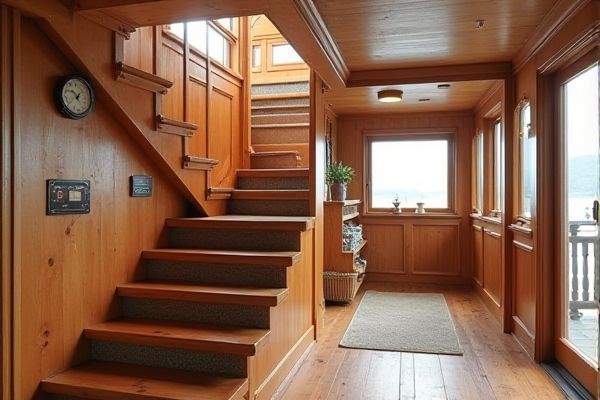
Ship ladder stairs offer a steep, compact design ideal for areas with limited floor space, providing a practical solution without sacrificing functionality. Explore the rest of the article to discover which option best fits your needs and how to optimize your space efficiently.
Table of Comparison
| Feature | Ship Ladder Stairs | Space-Saving Stairs |
|---|---|---|
| Design | Steep, angled with narrow treads | Compact, various designs like spiral or folding |
| Space Efficiency | More compact than traditional stairs but less than space-saving types | Maximizes floor space with minimal footprint |
| Safety | Requires careful use due to steepness | Safer, with wider treads and handrails |
| Installation | Simple install, usually fixed angle | Can be complex, depends on design (spiral, folding, retractable) |
| Use Case | Ideal for accessing lofts, basements in tight spaces | Best for small homes, apartments, areas needing maximum space saving |
| Material | Typically metal or wood | Varied: wood, metal, composite materials |
Introduction to Ship Ladder Stairs and Space-Saving Stairs
Ship ladder stairs feature steep, narrow steps designed for compact spaces, offering a balance between accessibility and minimal footprint. Space-saving stairs incorporate innovative designs such as alternating treads or spiral configurations to maximize usable floor area without sacrificing safety. Comparing these options highlights distinct trade-offs in ergonomics, installation complexity, and spatial efficiency for tight interior environments.
Key Differences Between Ship Ladder Stairs and Space-Saving Stairs
Ship ladder stairs feature steep, narrow treads and a steep angle, offering a compact solution primarily used in tight spaces such as lofts or ships. Space-saving stairs prioritize efficient use of vertical and horizontal space, often incorporating alternating tread designs or spiral configurations to maximize floor area without sacrificing safety. The key difference lies in ergonomics and application: ship ladders emphasize steepness and minimal footprint, while space-saving stairs balance accessibility with optimized spatial efficiency.
Design and Construction Features
Ship ladder stairs feature steep angles, narrow treads, and sturdy handrails, designed for compact vertical access with robust metal or wood construction. Space-saving stairs incorporate alternating tread patterns or spiral designs, maximizing floor space while maintaining ergonomic safety through engineered materials and precise measurements. Both designs emphasize efficient use of limited areas but differ in structural complexity and installation requirements.
Space Requirements and Installation Considerations
Ship ladder stairs require less floor space than traditional stairs but more than other space-saving options, making them ideal for areas with moderate space constraints. Installation demands careful attention to angle and support due to their steep incline, ensuring safety and stability. Your choice depends on balancing available space with the need for secure, code-compliant stair construction.
Safety and Building Code Compliance
Ship ladder stairs offer steep, compact design that requires careful adherence to strict building codes for handrails and tread dimensions to ensure safety. Space-saving stairs, often spiral or alternating tread types, prioritize maximizing floor area while meeting safety standards through specific rise and run measurements. Your choice must consider local regulations and the stair's intended use, balancing space constraints with safe, code-compliant access.
Comfort and Ease of Use
Ship ladder stairs offer a steep incline with narrow treads, making them less comfortable and more challenging to ascend or descend for extended use. Space-saving stairs feature wider steps and a gentler slope, enhancing comfort and ease of navigation in tight spaces. Your choice should consider how frequently the stairs are used, as space-saving options generally provide better ergonomics for daily use.
Ideal Applications for Ship Ladder Stairs
Ship ladder stairs are ideal for tight spaces requiring steep, compact access, often used in lofts, attics, or industrial settings where floor space is limited. Their steep angle and narrow steps maximize vertical ascent without sacrificing structural stability, making them suitable for emergency exits, maintenance platforms, or mezzanine access. Your choice of ship ladder stairs enhances safety and efficiency where traditional stairs cannot fit, offering a practical solution in confined areas.
Best Uses for Space-Saving Stairs
Space-saving stairs are ideal for compact areas where maximizing floor space is essential, such as tiny homes, lofts, and attics. Unlike ship ladder stairs, which combine steepness with sturdiness for industrial or nautical settings, space-saving stairs prioritize a compact footprint and efficient vertical movement. Your choice of space-saving stairs optimizes both accessibility and room functionality without compromising safety.
Cost Comparison and Maintenance Needs
Ship ladder stairs typically cost more due to their custom metal fabrication and sturdy design, while space-saving stairs are generally more affordable with simpler materials. Maintenance for ship ladders involves periodic inspection for rust and lubrication of moving parts, demanding moderate upkeep. Space-saving stairs require less maintenance, often needing only occasional cleaning and tightening of hardware.
Choosing the Right Stair Solution for Your Space
Ship ladder stairs provide a steep, compact option ideal for tight spaces where vertical clearance is limited, offering sturdy metal or wood construction for durability. Space-saving stairs feature innovative designs like alternating treads or spiral shapes that maximize floor area without compromising safety or accessibility. Your choice depends on balancing available space, usage frequency, and aesthetic preference to ensure efficient movement and functionality in your environment.
 homyna.com
homyna.com